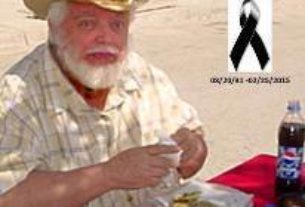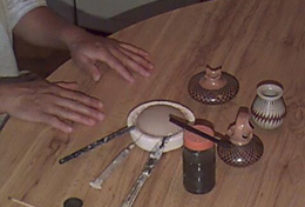On a huge hill, covered with weeds, small trees and debris, was built a church overlooking the city, the Sanctuary de los Remedies. It is a beautiful site, with the towered church silhouetted against the blue sky and the snow-capped peaks of Popocatepetl and Ixtaccihuatl in the background. It was discovered that this was not just a hill but a giant pyramid, the largest in the Americas. We are in the city of Cholula. Within the pyramid’s mass are claimed to be five miles of tunneling, a portion of which has been cleared, lighted, and opened to the public. As you pass through the pyramid there are tunnels branching off every which way, up, down and sideways, which you are not permitted to enter. The top of the tunneling is in the form of the corbel arch, such as was used at the Mayan site of Palanque and elsewhere. At the base of the pyramid other structures have been excavated and restored.
Cholula is probably the oldest continuously occupied city on the continent, dating back to 800 BC. At the time of the Conquest it was part of the Aztec domain. At its zenith, around 200 AD, Cholula probably had a population of around 100,000. In 1980 its population was about 13,000.
The following is a quote from another of Cortes’ writings: “The city….is more beautiful than any in Spain, for it is very well proportioned and has many towers, and they all have temples. I have counted more than 430 towers, and they were all temples. From here to the coast I have found no city so fit for Spaniards to live.” It is commonly stated that Cholula has a church for everyday in the year, some 365. I don’t think that is true. Nor am I sure that Cortes was giving an accurate impression of the city. I wonder if he wasn’t over-zealous in trying to impress the king with the magnitude of his discoveries and conquests. In any case, I consider his discoveries and adventures among the greatest in history and the conquest something of a miracle.
In 1843 William Prescott wrote “The Conquest of Mexico”, primarily from documents which he had access to, and which were not available to just any writer. The rest of this article is basically from his writings, for which I have the greatest respect. His statements of fact are accompanied by footnotes which give reference to the source. I believe the book is somewhat rare. I bought a copy at an ugly thrift store in Santa Ana, California, for twenty-five cents, years ago. No, its not for sale!
“1519. The ancient city of Cholula, capital of the republic of that name, lay nearly six leagues south of Tlascala and about twenty east, or rather, southeast of Mexico . It was said by Cortes to contain twenty thousand houses within the walls, and as many more in the environs. Whatever was its real number of inhabitants, it was unquestionably, at the time of the Conquest, one of the most populous and flourishing cities in New Spain.”
“It was of great antiquity, and was founded by the primitive races who overspread the land before the Aztecs. We have few particulars of its form of government, which seems to have been cast on a republican model similar to that of Tlascala. This answered so well that the state maintained its independence down to the very late period when, if not reduced to vassalage by the Aztecs, it was so far under their control as to enjoy few of the benefits of a separate political existence.”
“Their connection with Mexico brought the Cholulans into frequent collision with their neighbors and kindred, the Tlascalans. But although far superior to them in refinement and the various arts of civilization, they were no match in war for the bold mountaineers, the Swiss of Anahuac. The Cholulan capital was the great commercial emporium of the plateau. The inhabitants excelled in various mechanical arts, especially that of working in metals, the manufacture of cotton and agave cloths, and of a delicate kind of pottery rivalling, it was said, that of Florence in beauty. But such attention to the arts of a polished and peaceful community naturally indisposed them to war, and disqualified them for coping with those who made war the great business of life. The Cholulans were accused of effeminacy, and were less distinguished-it is the charge of their rivals-by their courage than their cunning.”
“But the capital, so conspicuous for its refinement and its great antiquity, was even more venerable for the religious traditions which invested it. It was here that the god Quetzalcoatl paused in his passage to the coast, and passed twenty years in teaching the Toltec inhabitants the arts of civilization. He made them acquainted with better forms of government and a more spiritualized religion, in which the only sacrifices were the fruits and flowers of the season. It is not easy to determine what he taught, since his lessons have been so mingled with the licentious dogmas of his own priests and the mystic commentaries of the Christian missionary. It is probable he was one of those rare and gifted beings who, dissipating the darkness of the age by the illumination of their own genius, are deified by a grateful posterity and placed among the lights of heaven.”
“It was in honor of this benevolent deity that the stupendous mound was erected, on which the traveller still gazes with admiration as the most colossal fabric in New Spain, rivalling in dimensions and somewhat resembling in form, the pyramidal structures of ancient Egypt. The date of the erection is unknown, for it was found there when the Aztecs entered on the plateau. It had a form common to the Mexican ‘tecallis’, that of a truncated pyramid, facing with its four sides the cardinal points and divided into the same number of terraces. Its original outlines, however, have been effaced by the action of time and of the elements, while the exuberant growth of shrubs and wild flowers, which have mantled over its surface, give it the appearance of one of those symmetrical elevations thrown up by the caprice of nature rather than by the industry of man. It is doubtful, indeed, whether the interior be not a natural hill, though it seems not improbable that it is an artificial composition of stone and earth, deeply incrusted, as is certain, in every part with alternate strata of brick and clay.”
“On the summit stood a sumptuous temple in which was the image of the mystic deity, “god of the air”, with ebon features, unlike the fair complexion which he bore upon earth, wearing a mitre on his head, waving with plumes of fire, with a resplendent collar of gold round his neck, pendants of mosaic turquoise in his ears, a jewelled sceptre in one hand, and a shield curiously painted, the emblem of his rule over the winds, in the other. The sanctity of the place, hallowed by hoary tradition, and the magnificence of the temple and its services, made it an object of veneration throughout the land, and pilgrims from the furthest corners of Anahuac came to offer up their devotions at the shrine of Quetzalcoatl.”
“Cholula was not the resort only of the indigent devotee. Many of the kindred races had temples of their own in the city, in the same manner as some Christian nations have in Rome, and each temple was provided with its own peculiar ministers for the service of the deity to whom it was consecrated. In no city was there seen such a concourse of priests, so many processions, such pomp of ceremonial, sacrifice, and religious festivals. Cholula was, in short, what Mecca is among Mahometans, or Jerusalem among Christians. It was the holy city of Anahuac.”
“The religious rites were not performed, however, in the pure spirit originally prescribed by its tutelary deity. His altars, as well as those of the numerous Aztec gods, were stained with human blood. Six thousand victims are said to have been annually offered up at their sanguinary shrines.”
Perhaps Cholula’s failure to keep pace was due to the Spaniards’ decision to build the city of Puebla close by. And perhaps it is because the Spaniards had a bad experience on their first visit.
Cortez, and his small army, after making its way through tropical Veracruz, ascending the Sierra Madre Sur, and their brief battle with the Tlaxcaltecas, made his way to Cholula, on their way to Tenochtitlan. They were accompanied by a large force of Tlaxcalan warriors. The Spaniards were well received in Cholula, but the Tlaxcalans were denied entry into the city. Cortez was advised that the Aztecs were planning an ambush with the cooperation of Cholula, and were camped nearby. What followed was Cortez initiated what turned out to be a great massacre. It was escalated by the entry of the Tlaxcalans on a given signal by the Spaniards.
I’ve often thought a movie should be made of the Conquest of Mexico. It had all of the ingredients of an epic novel.
- . . . Part IV
Published or Updated on: January 1, 2000


